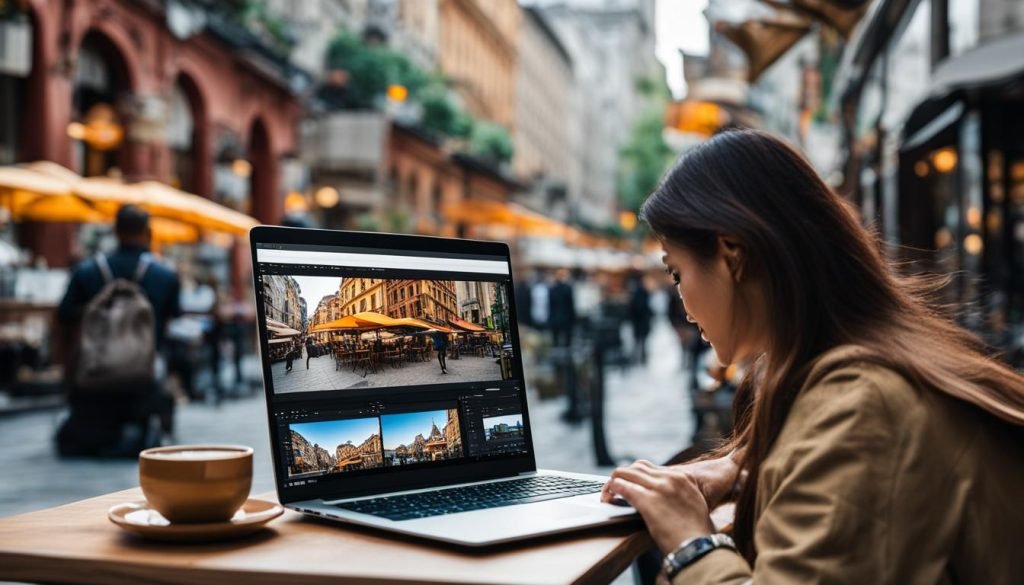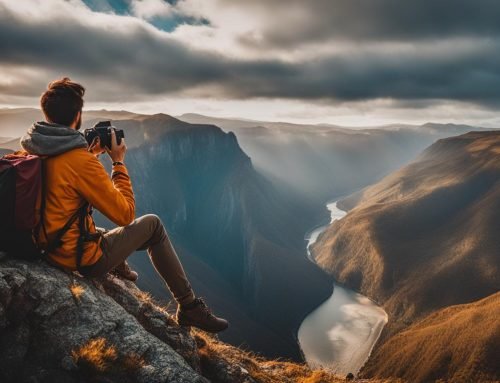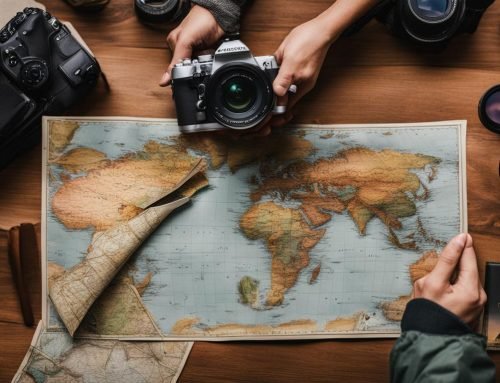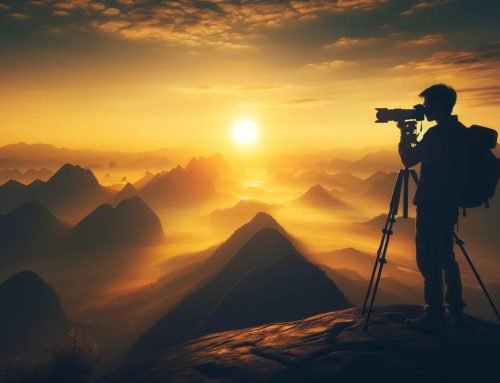
Enhance your travel photos and create stunning images that truly capture the essence of your journey with post-processing techniques. By using various editing techniques, you can enhance the colors, lighting, and composition of your travel pictures. This comprehensive guide will provide you with the necessary tools and knowledge to master post-processing for travel photography.
Key Takeaways:
- Post-processing enhances the colors, lighting, and composition of travel photos.
- Mastering post-processing techniques is essential for creating captivating travel images.
- Choosing the right editing software, such as Photoshop or Lightroom, is important for efficient editing.
- Essential editing techniques include adjusting exposure, enhancing colors, and retouching.
- Post-processing also plays a role in enhancing composition and storytelling in travel photos.
Importance of Post-Processing in Travel Photography
Post-processing plays a vital role in enhancing your travel photographs and bringing out the best in them. By utilizing various editing techniques, you can enhance the colors, contrast, and overall quality of your images. This allows you to create visually stunning travel pictures that truly capture the essence of your experiences. Post-production also enables you to correct any imperfections or distractions in your photos, ensuring that they showcase the beauty of your travel adventures.
One of the key benefits of post-processing is the ability to enhance the colors of your travel photographs. You can adjust the saturation and vibrancy, making the colors pop and creating a more vibrant and captivating image. Additionally, post-processing allows you to improve the contrast of your photos, bringing out the details in both the highlights and shadows. This helps to create a more dynamic and visually appealing composition.
Another important aspect of post-processing is the ability to fine-tune the overall quality of your travel images. Through editing techniques such as sharpening, noise reduction, and lens correction, you can enhance the sharpness, clarity, and overall visual impact of your photos. This helps to create a more polished and professional-looking final result. By investing time and effort into post-processing, you can transform your raw travel pictures into stunning works of art.
| Benefits of Post-Processing in Travel Photography |
|---|
| Enhances colors and contrast |
| Corrects imperfections and distractions |
| Improves overall quality and sharpness |
| Brings out the details in highlights and shadows |
Post-processing is an essential tool for travel photographers to elevate their images to the next level. By enhancing the colors, contrast, and overall quality of your travel photographs, you can create captivating visuals that truly showcase your travel experiences. So, don’t overlook the importance of post-processing in your photography journey and embrace it as a powerful tool to bring out the best in your travel pictures.
Choosing the Right Editing Software for Travel Photos
When it comes to post-processing your travel photos, choosing the right editing software is crucial to achieve the desired enhancements. Two popular options among photographers are Adobe Photoshop and Lightroom. While both offer powerful editing capabilities, each software has its own unique features and benefits.
Adobe Photoshop
Adobe Photoshop is a widely used software for manipulating and editing images. It provides advanced retouching tools that allow you to make precise adjustments to your travel photos. With Photoshop, you can remove unwanted objects, correct imperfections, and extensively manipulate the composition and colors of your images. This software is ideal if you prefer a high level of control and want to create more artistic and conceptual edits.
Lightroom
On the other hand, Lightroom is known for its user-friendly interface and efficient workflow. Lightroom is designed specifically for managing and editing large volumes of photos, making it a great choice for travel photographers who have a lot of images to process. It offers a range of editing tools to enhance colors, exposure, and overall image quality. Lightroom also allows you to easily organize and categorize your travel photos, making it easier to find and compare images.
Ultimately, the choice between Photoshop and Lightroom depends on your specific needs and preferences as a travel photographer. If you prioritize extensive editing capabilities and artistic control, Photoshop may be the better option for you. However, if you value efficiency, ease of use, and a streamlined workflow, Lightroom may be the ideal choice. It’s worth experimenting with both software to determine which one suits your editing style and enhances your travel images the best.
| Adobe Photoshop | Lightroom |
|---|---|
| Advanced retouching tools | User-friendly interface |
| Extensive image manipulation capabilities | Efficient workflow for managing large volumes of photos |
| Perfect for artistic and conceptual edits | Easy organization and categorization of images |
Essential Editing Techniques for Travel Photography
To enhance your travel photos and make them visually appealing, there are several essential editing techniques that you should master. These techniques will help you retouch your travel pictures and bring out the best in them. Whether you’re adjusting exposure and white balance, enhancing colors, sharpening details, or correcting lens distortions, these editing techniques will elevate the overall quality of your travel photos.
Adjusting Exposure and White Balance
One of the key editing techniques for travel photography is adjusting the exposure and white balance. Proper exposure ensures that your photos are neither too dark nor too bright, while white balance helps you achieve accurate colors. Pay attention to the histogram and adjust the exposure slider to achieve the desired tonal range. Use the white balance settings to ensure that the colors in your photos look natural and true to life.
Enhancing Colors and Sharpening Details
To make your travel photos stand out, it’s important to enhance the colors and sharpen the details. Use the saturation and vibrance sliders to boost the colors and make them more vibrant. Adjust the contrast and clarity sliders to bring out the details and make the photo look sharper. Be careful not to overdo these adjustments, as it can result in an unnatural or artificial look.
Correcting Lens Distortions
Lens distortions can often occur in travel photos, especially when using wide-angle lenses. These distortions can include barrel distortion, vignetting, or chromatic aberration. To correct these issues, use the lens correction tools available in your editing software. Adjust the sliders to remove any distortions and ensure that the lines in your photos are straight and free from any unwanted effects.
| Editing Technique | Description |
|---|---|
| Adjusting Exposure and White Balance | Ensure proper exposure and accurate colors in your travel photos. |
| Enhancing Colors and Sharpening Details | Make your travel photos more vibrant and detailed. |
| Correcting Lens Distortions | Remove any distortions caused by your camera lens. |
By mastering these essential editing techniques, you’ll be able to retouch your travel pictures and create stunning images that capture the beauty of your journeys. Remember to experiment, trust your artistic vision, and find your own unique editing style. With practice and patience, you’ll be able to take your travel photography to the next level.
Enhancing Composition and Storytelling in Travel Photos
When it comes to capturing the essence of your travel experiences through photography, composition and storytelling play a vital role. It’s not just about taking a technically perfect photo; it’s about creating a visually engaging image that resonates with the viewer. In this section, we will explore various techniques to enhance composition and storytelling in your travel photos.
Composition is the arrangement of elements within the frame of your photo. It involves considering the placement of your subject, the use of lines and shapes, and the balance of various elements to create a visually pleasing image. By paying attention to composition, you can guide the viewer’s eye and create a focal point that effectively communicates the story you want to tell.
One technique to enhance composition is through cropping and straightening. Sometimes, the original image may have distractions or unnecessary elements that detract from the main subject. By cropping or straightening the photo, you can eliminate these distractions and create a stronger visual impact. Additionally, adjusting the composition through these techniques can help you highlight specific details or create a sense of depth in your images.
Using Overlays and Selective Editing
Besides composition, storytelling is an essential aspect of travel photography. It allows you to convey the emotions, atmosphere, and narrative of a place or moment. One way to enhance storytelling in your photos is by using overlays and selective editing.
Overlays are additional elements that you can add to your photos to enhance the mood or evoke a specific feeling. For example, you can add a subtle texture overlay to give your image a vintage or film-like look. Alternatively, you can use a vignette overlay to draw attention to the central subject and create a sense of intimacy.
Selective editing involves applying adjustments or effects to specific areas within your photo. This technique allows you to highlight or enhance certain elements while maintaining the integrity of the overall image. For example, you can selectively adjust the exposure of the sky to make it more vibrant or darken the foreground to create contrast and depth. By using overlays and selective editing, you can add layers of meaning and storytelling to your travel photos.
| Composition Techniques | Storytelling Techniques |
|---|---|
|
|
By utilizing these composition and storytelling techniques, you can elevate the impact of your travel photos and create images that truly resonate with your audience. Remember to experiment and explore different approaches to find your unique style and voice as a travel photographer.
Presets and Filters for Efficient Editing Workflow
When it comes to post-processing your travel photos, using presets and filters can significantly streamline your editing workflow and help you achieve consistent and stylized looks for your images. Presets are pre-configured settings that can be applied to your photos with a single click, saving you time and effort in adjusting various editing parameters manually. They offer a quick and easy way to enhance your images and achieve a desired look or mood.
Filters, on the other hand, allow you to add creative effects to your travel photos. Whether you want to create a vintage, black and white, or film-inspired look, filters can help you achieve the desired aesthetic. They can add a unique touch to your images and make them stand out from the crowd. By experimenting with different presets and filters, you can find the perfect combination that suits your style and enhances the visual impact of your travel photos.
Retaining a Natural Look in Post-Processing
While post-processing can greatly enhance your travel photos, it is crucial to maintain a natural look and avoid over-editing. The goal is to enhance the image without making it look overly manipulated or unrealistic. By following some key principles and being mindful of your editing choices, you can achieve a natural-looking result that preserves the scene’s authenticity.
Firstly, pay attention to subtle adjustments. It’s often the small, subtle changes that can make a big difference in the overall look and feel of your photo. Avoid drastic alterations that significantly change the colors, contrast, or overall appearance of the image. Instead, focus on enhancing the existing beauty of the photo and bringing out its best qualities.
Secondly, use your judgment to strike a balance. It’s important to trust your instincts and avoid going overboard with editing. Ask yourself if the changes you are making still reflect the essence of the scene and if they enhance the overall composition and storytelling of the photo. Remember, less can often be more when it comes to post-processing.
Lastly, consider the purpose of the photo. Think about how the image will be used or displayed. If it’s for a travel blog or social media, maintaining a natural look can help create a sense of authenticity and connect with your audience. On the other hand, if it’s a more artistic or conceptual piece, you may have more freedom to experiment with different editing styles. Always keep the end goal in mind and let that guide your editing decisions.
To summarize, retaining a natural look in post-processing is essential to create visually appealing travel photos. By making subtle adjustments, using your judgment, and considering the purpose of the photo, you can strike a balance between enhancing the image and maintaining its natural appeal. Keep in mind that the goal is to showcase the beauty of your travel experiences and evoke emotions, rather than creating an overly manipulated or unrealistic result.
Workflow Tips for Efficient Post-Processing
When it comes to post-processing your travel photos, establishing an efficient workflow is key to saving time and ensuring a streamlined editing process. By following these workflow tips, you can optimize your post-processing tasks and focus more on capturing new travel memories.
Organize your travel photos
Start by organizing your travel photos in a logical folder structure. Create folders for each destination or trip, and further categorize them by dates or specific locations. This will make it easier to find and manage your photos during the editing process. Additionally, consider using rating or flagging systems to identify your best shots and prioritize them for editing.
Utilize batch editing techniques
Batch editing is a time-saving technique that allows you to apply similar adjustments to multiple photos at once. For example, if you have a series of photos taken in the same lighting conditions, you can apply the same exposure or color adjustments to all of them. This ensures consistency across your images and reduces the time spent on individual edits.
Make use of keyboard shortcuts and presets
Keyboard shortcuts and presets can significantly speed up your editing tasks. Learn and memorize commonly used keyboard shortcuts for your editing software to perform functions quickly. Additionally, create and save custom presets for common edits or effects that you frequently use. This way, you can apply them with just a few clicks, saving time and maintaining a consistent editing style.
By implementing these workflow tips, you can establish an efficient post-processing process for your travel photos. From organizing your photos to utilizing batch editing techniques and leveraging shortcuts and presets, these strategies will help you optimize your workflow and make the most of your editing time.
| Workflow Tips for Efficient Post-Processing |
|---|
| Organize your travel photos |
| Utilize batch editing techniques |
| Make use of keyboard shortcuts and presets |
Balancing Consistency with Creative Freedom in Editing
When it comes to editing your travel photos, finding the right balance between consistency and creative freedom is essential. Consistency ensures that your portfolio or social media feed maintains a cohesive visual style, making it easier for your audience to recognize your work. However, it’s equally important to allow room for creative expression and adapt your editing style to suit the unique characteristics of each photo.
Aim to establish a consistent overall look for your travel photos, whether it’s through color grading, lighting adjustments, or composition techniques. This will help create a cohesive narrative and visual identity in your body of work. However, don’t be afraid to experiment and push the boundaries of your creativity. Allow yourself the freedom to explore different editing techniques, presets, and filters that enhance the mood and story of each individual photo.
Ultimately, your goal is to strike a balance between maintaining consistency and expressing your artistic vision. While it’s important to showcase your unique style, it’s equally important to let the subject matter and context of each photo guide your editing decisions. By finding this balance, you can create travel photos that not only captivate your audience but also reflect your personal style and the emotions you experienced during your travels.
Strategies for Balancing Consistency and Creative Freedom
- Establish a consistent color palette or toning style to create a cohesive look across your travel photos.
- Experiment with different editing techniques to enhance the mood and story of each individual photo.
- Consider the subject matter and context of each photo when making editing decisions.
- Seek inspiration from other photographers and artists, but adapt their techniques to suit your own style.
- Regularly evaluate and refine your editing style to ensure it aligns with your evolving artistic vision.
Remember, finding the balance between consistency and creative freedom is an ongoing process. As you gain more experience and refine your skills, your editing style will continue to evolve. Embrace this journey and stay true to your unique voice as a travel photographer.
| Consistency | Creative Freedom |
|---|---|
| Creates a cohesive visual style | Allows for personal expression |
| Maintains a recognizable brand | Encourages experimentation and growth |
| Produces a cohesive narrative | Allows for adaptation to different subjects |
Experimenting and Finding Your Editing Style
Post-processing is a creative journey that allows you to explore your unique vision and style when it comes to editing your travel photos. It’s an opportunity to experiment with different techniques, presets, and filters to discover what resonates with you and enhances the story you want to tell. By taking the time to experiment and find your editing style, you can create images that truly reflect your artistic voice.
When starting your experimentation process, don’t be afraid to step out of your comfort zone and try new approaches. Play with different color palettes, contrasts, and tones to see how they can transform the mood and impact of your images. You can also explore various editing tools and software features to truly understand their capabilities and how they can help you achieve your desired effects.
It’s important to remember that finding your editing style is a fluid process that evolves over time. As you gain more experience and refine your skills, your style will naturally develop and mature. Embrace this evolution and allow yourself the freedom to grow and adapt as an artist.
Embracing Imperfections and Uniqueness in Your Images
As you experiment and find your editing style, it’s important to embrace imperfections and recognize the uniqueness of your images. Every photo has its own story to tell, and sometimes imperfections can add character and depth to your composition. Don’t be afraid to preserve the authenticity of the scene and let your individuality shine through in your edits.
Remember, experimentation is about pushing boundaries and exploring new possibilities. Don’t be discouraged by mistakes or unsuccessful attempts. They are valuable learning opportunities that can help you refine your craft and ultimately create more compelling images.
By embracing imperfections and embracing your unique style, you can create a portfolio of travel photos that truly capture your perspective and leave a lasting impression on your viewers.
| Benefits of Experimenting with Post-Processing | How to Experiment with Post-Processing |
|---|---|
|
|
Experimentation is a vital part of the creative process in post-processing. It allows you to discover your own unique editing style, embrace imperfections, and create compelling images that reflect your artistic vision. So, grab your camera, unleash your creativity, and let your travels inspire you as you embark on the journey of finding your editing style.
Conclusion
In conclusion, mastering post-processing techniques is crucial for enhancing your travel photography. By utilizing the right editing software and implementing essential techniques, you can create captivating travel photos that truly bring your experiences to life. Remember to balance enhancing your images with maintaining a natural look, and establish an efficient workflow to optimize your post-processing process.
Experimentation is key when it comes to finding your own unique editing style. Try different techniques, presets, and filters to discover what works best for your travel photos. Pay attention to feedback from others, but ultimately trust your own artistic vision and intuition. Your editing style will evolve over time as you gain more experience, so don’t be afraid to push the boundaries of your creativity.
With practice and perseverance, you can elevate your post-processing skills and create travel images that tell a compelling story and evoke emotions. Remember that post-processing is not just about enhancing technical aspects; it also plays a significant role in enhancing composition and storytelling. So, go out there, capture new travel memories, and let your post-processing skills shine!
FAQ
What is the importance of post-processing in travel photography?
Post-processing allows you to enhance the colors, contrast, and overall quality of your travel photos, creating visually appealing images that showcase the beauty of your travel experiences.
What software options are available for post-processing travel photos?
Adobe Photoshop and Lightroom are popular choices among photographers for their wide range of editing capabilities. Photoshop offers advanced retouching tools, while Lightroom provides a user-friendly interface and efficient workflow for managing and editing large volumes of photos.
What are some essential editing techniques for travel photography?
Essential editing techniques for travel photography include adjusting exposure and white balance, enhancing colors, sharpening details, correcting lens distortions, and retouching to remove unwanted objects or distractions from your photos.
How can post-processing enhance composition and storytelling in travel photos?
By cropping, straightening, or adjusting the composition, you can improve the visual impact of your images and create a stronger focal point. Additionally, using techniques like selective editing or adding overlays can enhance the narrative and emotions within the photo, creating a more engaging story for the viewer.
What are presets and filters, and how can they streamline the editing workflow?
Presets are pre-configured settings that can be applied to your images with a single click, allowing you to achieve consistent and stylized looks for your travel photos. Filters can be used to add creative effects. Utilizing presets and filters can save time and create a consistent aesthetic for your travel photos.
How can I retain a natural look in post-processing?
It’s important to avoid over-editing your travel photos to preserve the authenticity of the scene. Aim to enhance the existing beauty of the photo without making it look overly manipulated. Striking a balance between enhancing the image and maintaining its natural appeal is key.
What are some workflow tips for efficient post-processing?
Establish an efficient workflow by organizing your travel photos in a logical folder structure, rating or flagging your best shots, and utilizing batch editing techniques to apply similar adjustments to multiple photos. Using keyboard shortcuts and custom presets can also speed up your editing tasks.
How can I balance consistency with creative freedom in editing?
Consistency is important in maintaining a cohesive visual style, but it’s also important to allow room for creative expression and adapt your editing style to suit the unique characteristics of each photo. Aim for a consistent overall look while allowing individual images to shine and tell their own stories.
How can I find my own editing style?
Experiment with different techniques, presets, and filters to discover what works best for your travel photos. Pay attention to feedback and reactions, but ultimately trust your artistic vision and intuition. Your editing style will evolve over time as you gain more experience and refine your skills.




